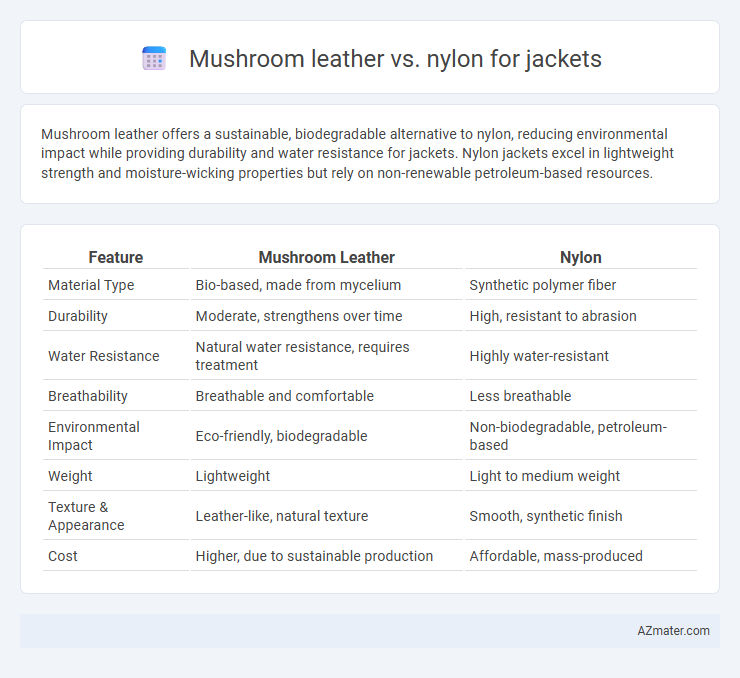Mushroom leather offers a sustainable, biodegradable alternative to nylon, reducing environmental impact while providing durability and water resistance for jackets. Nylon jackets excel in lightweight strength and moisture-wicking properties but rely on non-renewable petroleum-based resources.
Table of Comparison
| Feature | Mushroom Leather | Nylon |
|---|---|---|
| Material Type | Bio-based, made from mycelium | Synthetic polymer fiber |
| Durability | Moderate, strengthens over time | High, resistant to abrasion |
| Water Resistance | Natural water resistance, requires treatment | Highly water-resistant |
| Breathability | Breathable and comfortable | Less breathable |
| Environmental Impact | Eco-friendly, biodegradable | Non-biodegradable, petroleum-based |
| Weight | Lightweight | Light to medium weight |
| Texture & Appearance | Leather-like, natural texture | Smooth, synthetic finish |
| Cost | Higher, due to sustainable production | Affordable, mass-produced |
Introduction: Comparing Mushroom Leather and Nylon for Jackets
Mushroom leather, derived from mycelium, offers a sustainable and biodegradable alternative to traditional synthetic materials like nylon. Nylon provides durability, water resistance, and lightweight properties, making it a common choice for jackets in activewear and outdoor gear. Comparing the two materials highlights the balance between eco-friendly innovation and performance-oriented functionality in jacket manufacturing.
Environmental Impact: Mushroom Leather vs Nylon
Mushroom leather, derived from sustainable mycelium growth, offers a biodegradable and low-carbon footprint alternative to traditional nylon, which is petroleum-based and contributes significantly to microplastic pollution. The production of mushroom leather requires less water and energy compared to nylon, significantly reducing greenhouse gas emissions during manufacturing. Mushroom leather's compostability enhances circularity, whereas nylon's persistence in ecosystems underscores its environmental drawbacks.
Material Source and Production Process
Mushroom leather is derived from sustainable mycelium, the root structure of fungi, which grows rapidly using minimal water and no pesticides, making it an eco-friendly alternative to traditional materials. In contrast, nylon is a synthetic polymer produced through energy-intensive processes reliant on petrochemicals, contributing to higher carbon emissions and environmental degradation. The production of mushroom leather involves low-impact fermentation and biodegradable treatments, while nylon manufacturing requires chemical synthesis and extrusion, often resulting in non-biodegradable waste.
Durability and Longevity
Mushroom leather, derived from sustainable fungal mycelium, offers excellent durability with natural resistance to wear, making it a biodegradable and eco-friendly alternative to traditional materials. Nylon, a synthetic polymer, excels in tensile strength and abrasion resistance, providing superior longevity in harsh weather conditions due to its water and UV resistance properties. While mushroom leather emphasizes environmental sustainability and moderate durability, nylon jackets typically outperform in lifespan and rugged use scenarios.
Comfort and Breathability
Mushroom leather offers superior breathability compared to nylon, as its natural mycelium structure allows air circulation, reducing heat buildup and moisture retention. Nylon jackets, while durable and water-resistant, often trap heat and sweat due to their synthetic fibers, making them less comfortable for extended wear. The biodegradable nature of mushroom leather also enhances comfort by minimizing irritation found in synthetic materials.
Water Resistance and Weather Performance
Mushroom leather offers superior water resistance compared to nylon, as its natural mycelium structure repels moisture while allowing breathability, reducing sweat accumulation during wet weather. Nylon jackets, although lightweight and quick-drying, can absorb water through seams and often require waterproof coatings that may degrade over time. In extreme weather conditions, mushroom leather maintains durability and water resistance without compromising flexibility, whereas nylon depends heavily on synthetic treatments for optimal weather performance.
Style and Aesthetic Appeal
Mushroom leather offers a unique, eco-friendly texture with a matte finish that enhances jacket style by providing a modern, sustainable aesthetic, while nylon jackets feature a sleek, shiny surface suited for sporty and casual looks. The organic patterns and softness of mushroom leather create a more luxurious and artisan appearance compared to the utilitarian and lightweight nature of nylon. Consumers seeking fashionable outerwear with an emphasis on sustainability often prefer mushroom leather for its distinctive visual appeal and natural vibe.
Cost and Market Availability
Mushroom leather, an innovative sustainable material, tends to be more expensive than traditional nylon due to limited production scale and complex manufacturing processes. Nylon jackets dominate the market with widespread availability and lower costs, benefiting from established supply chains and mass production. Consumers seeking eco-friendly options may face higher prices and limited choices when opting for mushroom leather jackets.
Sustainability and Eco-Friendliness
Mushroom leather, derived from mycelium, offers a sustainable alternative to nylon by utilizing renewable resources and biodegradable materials that reduce environmental impact. Nylon production relies heavily on non-renewable petroleum and emits significant greenhouse gases, contributing to pollution and waste challenges. Choosing mushroom leather for jackets promotes eco-friendliness through lower carbon footprint and enhanced biodegradability compared to synthetic nylon fabrics.
Conclusion: Which is Better for Jackets?
Mushroom leather offers superior sustainability, biodegradability, and a unique texture, making it an innovative choice for eco-conscious jacket manufacturers and consumers. Nylon excels in durability, water resistance, and affordability, suitable for performance-oriented outerwear requiring longevity and weather protection. The best choice depends on priorities: mushroom leather for environmentally friendly, stylish jackets, and nylon for functional, long-lasting outerwear.

Infographic: Mushroom leather vs Nylon for Jacket
 azmater.com
azmater.com